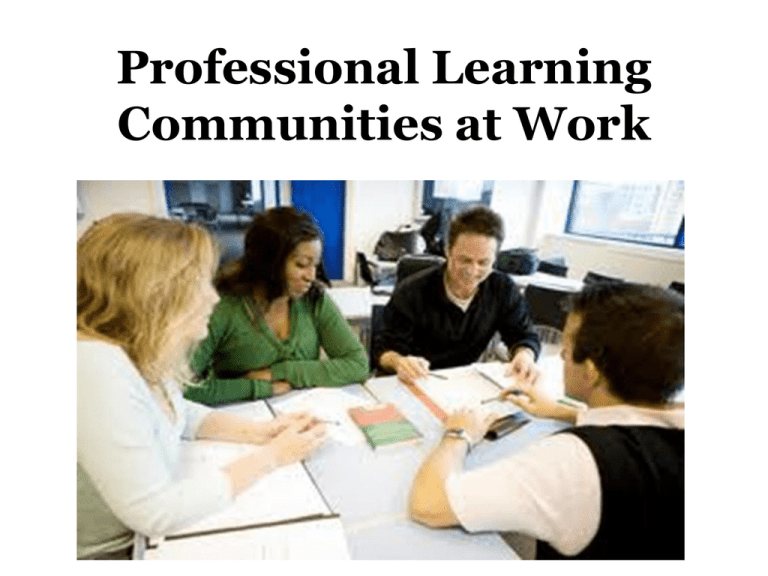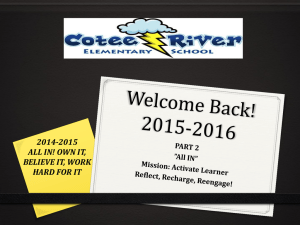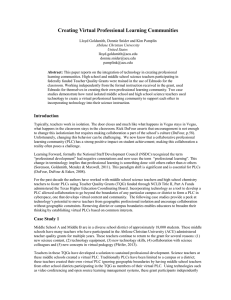Powerpoint Presentation
advertisement

Professional Learning Communities at Work The Real Question • Why are Professional Learning Teams so critical? • How are they linked to student learning? Ask Yourself? • Do I meet the needs of all learners in my classroom? • Do I have enough time to plan effectively for re-teaching so that all students learn? • Are all my students successful and ready for the next grade? The Power of Professional Learning Communities “The most promising strategy for sustained, substantive school improvement is building the capacity of school personnel to function as a professional learning community.” McLaughlin, 1995 The path to change in the classroom lies within and through professional learning communities. On PLCs….. “The best strategy for improving schools and districts is developing the collective capacity of educators to function as members of a Professional Learning Community (PLC)—a concept based on the premise that if students are to learn at higher levels, processes must be in place to ensure the ongoing, job-embedded learning of the adults who serve them”. Rick DuFour, co-author of Leaders of Learning Dr. Anthony Muhammad… http://www.youtube.com/watch?v=C9QD6xMns hA www.newfrontier21.com www.allthingsplc.com Traditional School Structure 5K Individual Individual Individual 1st gr. Individual Individual Individual 2nd gr. Individual Individual Individual 3rd gr. Individual Individual Individual 4th gr. Individual Individual Individual 5th gr. Individual Individual Individual 6th gr. Individual Individual Individual Independent Kingdoms Pseudo PLC Structure Kindergarten Group First Grade Group Second Grade Group Third Grade Group Fourth Grade Group Fifth Grade Group Sixth Grade Group Individual Kingdoms Interdependent Collaborative Teams Shared Purpose PLC Kindergarten Team First Grade Team Second Grade Team Third Grade Team Fourth Grade Team Shared Collective Shared Vision Commitments Goals Cohesive Foundation Paradigm Shifts…. Old Paradigm Every Student CAN learn Assessment OF Learning (Summative) Teach and move on Winners and Losers Focus on Teaching New Paradigm Every Student WILL learn Assessment FOR Learning (Formative) Pyramid of Intervention Failure is Not an Option Focus on Learning Professional Learning Community Defined An ongoing process in which educators work collaboratively in recurring cycles of collective inquiry and action research to achieve better results for the students they serve. PLCs operate under the assumption that the key to improved learning for students is continuous, jobembedded learning for educators. (DuFour, DuFour, Eaker, and Many, 2010) The BIG IDEAS of a PLC…. 1. Ensure that all students learn at high levels. 2. Create a collaborative culture. 3. Focus on results. The BIG IDEAS of a PLC…. Ensure that all students learn at high levels by focusing on four critical questions: 1. What do we want students to learn? 2. How will we know if they learn it? 3. What will we do if they do not learn it? 4. How can we enrich those who do learn it? What Do We Want Students To Learn? The PLC commits to: • a guaranteed and viable curriculumthe priority standards, skills, and essential outcomes. • embedded learning targets and agrees on the depth of knowledge. How Will We Know if They Learn It? The PLC: • gathers evidence of student learning through common assessments. • establishes criteria to assess the quality of student work. • collectively analyzes the data to determine next steps. What Will We Do If They Do Not Learn It? The PLC: • determines re-teaching/intervention strategies different from first strategies used. • Implements systematic interventions for students based on need. • Checks the collective ability of the team. • Provides feedback to and from students. Pyramid of Interventions DATA WALL SAMPLE: C. Harris 3rd Fall 2011-12 ELA MAP / Spring 2011 PASS results < 11% MAP 11-24% MAP 25%+ MAP Interventions/ Enrichments Interventions/ Enrichments Interventions/ Enrichments Student 2 150-230 NM Student 9 275-350 NM Student 18 450-580 M Student 3 190-270 NM Student 10 310--450 NM Student 19 450-580 M Student 4 210-300 NM Student 11 275-380 M Student 5 210-300 NM Student 17 300-400 NM Student 6 210-300 NM Student 16 380=450 M Student 7 210-300 NM Student 15 275-350 M Student 8 210-300 NM Student 14 300-450 NM Student 1 NM L 200-290 Student 13 275-350 M Student 12 450-600 NM Student 20 600-750 M How Can We Enrich Those Who DO Learn It? The PLC: • differentiates through extended learning activities. • assists students to a deeper understanding of concepts by applying the new learning. www.foridahoteachers.org What Will It Look Like? Setting Up The Teams - Teams determine Norms for Meeting - Teams receive the expectations for meetings from principal - Teams determine meeting times and places Action Steps in Planning Sessions - Look at current data to determine student weaknesses - Select concepts or skills to be taught based on state standards – develop Smart Goals - Create or select common assessments and set the criteria for student performance on the assessment (percentage to meet criteria) - Use all resources for planning of instruction (CCSS, district guides, teacher guides, state support documents, researched lessons - Discuss and share instructional strategies and teach the lessons - Make adjustments in common assessments and/or instructional plans accordingly - Regroup students for interventions or enrichment. After the Process - Provide feedback to students - As a team celebrate the successes of students Action Steps in Planning • Select concepts or skills to be taught based on state standards – develop Smart Goals. • Create or select common assessments and set the criteria for student performance on the assessment (percentage to meet criteria). • Use all resources for planning of instruction (CCSS, district guides, teacher guides, state support documents, researched lessons). • Discuss and share instructional strategies and teach the lessons. After teaching, give common assessments – Teachers record the data for analysis. • Adjust common assessments and/or instructional plans accordingly. • Regroup students for interventions or enrichment. Reassess SMART GOALS • • • • • Strategic and specific Measurable Attainable Results-oriented Time bound Which of these are SMART goals? By the end of the school year we will: • Develop and administer 5 common assessments • Implement the Common Core state standards in 100% of our classrooms • Increase the percentage of students achieving and exceeding the target score (80% or higher) on each strand of our end –of- theyear assessment from 81% last year to at least 90% this year. www.allthingsplc.com Go to www.allthingsplc.com to find: • • • • • Research articles School success stories PLC forms Getting started suggestions ALL THINGS related to PLCs! Suggested resources: Web-sites: www.allthingsplc.com www.newfrontier.com www.leadandlearn.com www.learningforward.com www.ed.sc.gov (Click: I’m looking for common core…. Common core support site; look on left column under “resources”) http://www.s2temsc.org http://engageny.org Suggested Books: • The School Leader’s Guide to Professional Learning Communities at WorkDuFour • Transforming School Culture- Muhammad • Learning by Doing -DuFour • Leaders of Learning- DuFour and Marzano





